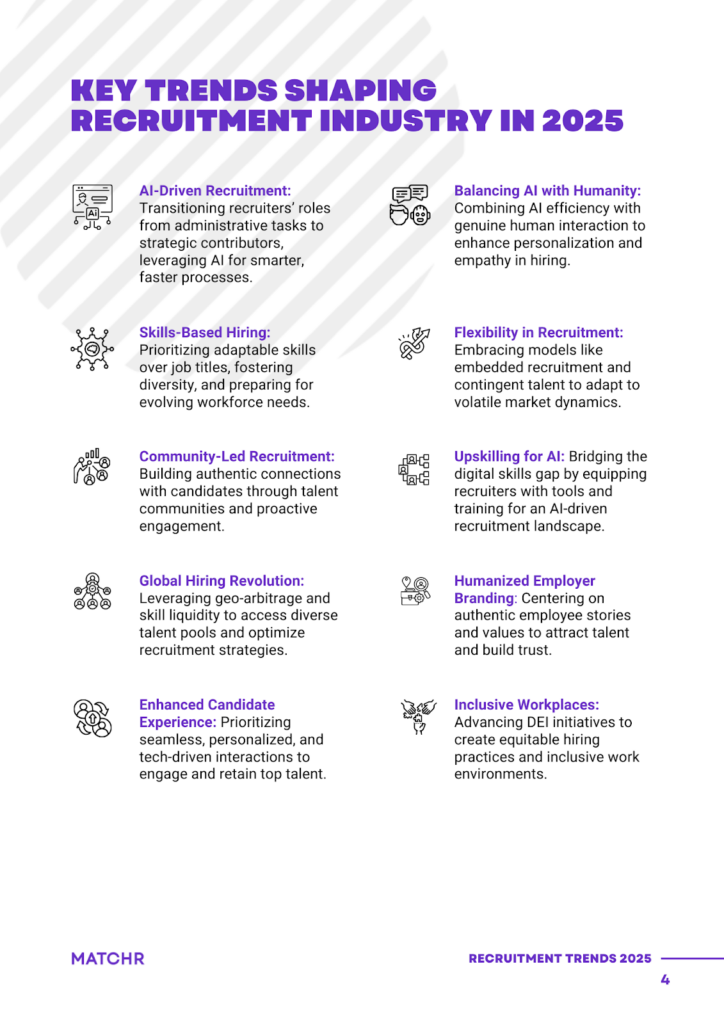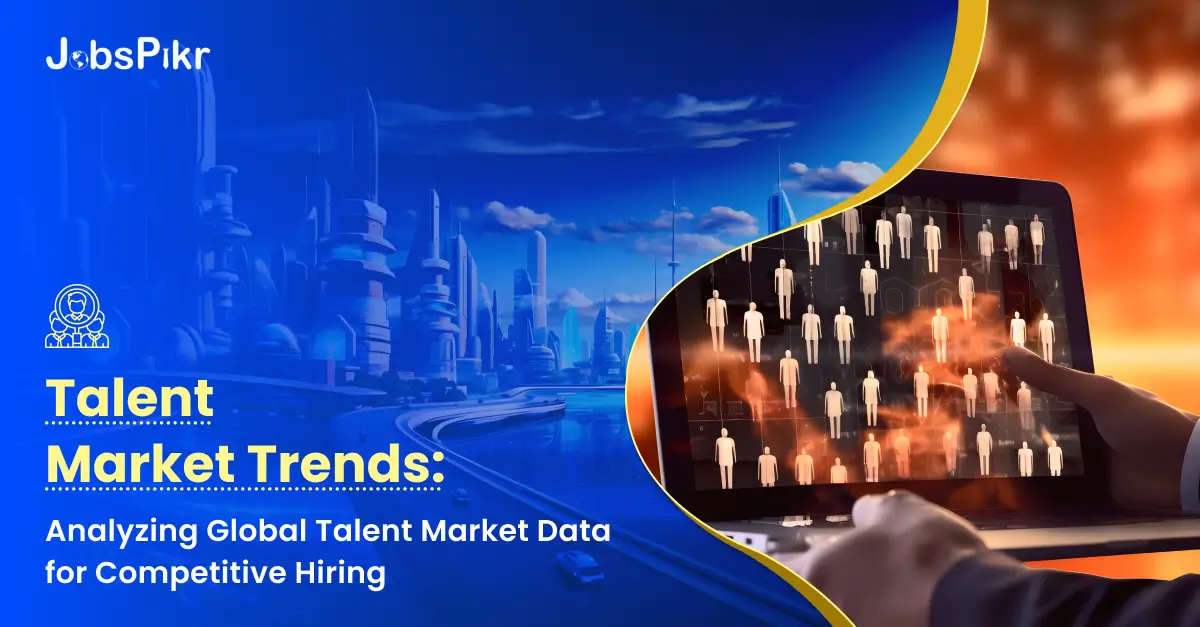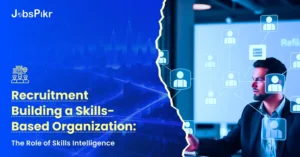Technological developments, changing workforce expectations, and economic changes are profoundly shaping the global talent market. In 2025, skill gaps and competition for niche roles have become prominent issues for organizations. For example, inFeedo recently reported that 77% of employers globally struggle to fill vacancies, which is the highest shortage of available skilled talent in the past 17 years.
These gaps in recruitment are of utmost importance to Chief Human Resource Officers (CHROs), recruitment heads, and talent intelligence teams focusing on these areas. A well-conducted talent market analysis exposes numerous prospects that, when correctly approached, can elevate the organization’s status. This report focuses on talent market trends that will affect the global talent market in 2025, examines how data analytics can bolster hiring policies and strategies, and incorporates AI for the prediction of high-demand positions.
Key Talent Market Trends Impacting Hiring in 2025

Image Source: Matchr
Focusing on adaptations of the job market reveals shifts in the past years. In order to maintain relevancy, organizations need to follow the trends in their areas of interest– in this case, talent recruitment and talent trends for the year 2025.
1. Skills-Based Hiring Over Traditional Degree Requirements
More companies are shifting their focus from hiring based on academic qualifications to skills, certifications, and relevant work experience. Greater emphasis is now being placed on technical skills, problem-solving, and adaptability as compared to education credentials.
A report from LinkedIn for 2024 states that there was an over 20% increase in job postings with a focus on skills as opposed to degree requirements in the past two years. This is especially true for the technology, marketing, and finance fields. For recruiters, this means changing the focus of their job descriptions to target appropriate capabilities as opposed to rigid academic requirements.
2. Remote and Hybrid Work Models Are Here to Stay
The workplace continues to evolve, and remote work will remain a dominant trend in 2025. Hybrid work models—where employees split time between home and office—have become the new norm across industries.
Companies offering flexible work arrangements gain a competitive advantage by accessing a broader talent pool beyond their immediate location. Talent market insights suggest that businesses embracing remote work can hire skilled professionals from different regions, reducing hiring costs and improving workforce diversity.
3. AI and Automation Reshaping Job Roles
The artificial intelligence revolution has impacted nearly every job role across the board due to its use in various business processes. Rote workforce activities are now AI-enabled, resulting in the use of peripheral skills such as automation engineering, data science, and AI development.
For employer recruiters, knowing the rate of employment shifts alongside new demand is key for effective workforce readiness. The businesses that integrate talent market analytics into their systems stand to benefit by anticipating future recruitment needs, thereby obtaining the requisite personnel that align with the company’s operational objectives.
4. The Rise of Green Jobs and Sustainability Roles
There has been an increase in emerging employment opportunities, green jobs, primarily due to the heightening focus on sustainability by governments and corporations. Jobs concerned with renewables like ESG (Environmental, Social, and Governance) frameworks, as well as mitigation of climate change, are growing in various sectors.
ILO’s study suggests that the global endeavor towards sustainability is likely to culminate in the creation of around 24 million jobs by the year 2030. With companies now understanding the need to invest in sustainability projects, they need to adopt new recruitment strategies geared towards hiring experts in environmental management, carbon footprint culimination, and clean energy.
5. Diversity, Equity, and Inclusion (DEI) as a Business Priority
One of the most important factors in forming new teams or improving existing ones is fostering an inclusive culture at the workplace. Most organizations are adopting responsive hiring practices, actively utilizing AI for bias mitigation in recruitment, and working towards achieving specific DEI objectives within given timelines.
According to McKinsey’s report, businesses whose employees belong to diverse demographic groups, and which are in the highest performance quartile for diversity, are 25% more likely to achieve above-average profitability. This makes it evident that integrating DEI at every level of the organization enhances the chances of sustained success.
How Talent Market Analysis Helps Businesses Identify Hiring Opportunities
The dynamic nature of the market means businesses must vary the strategies they use to attract and retain talent and tailor them to shifts in industry trends recommended by talent market analysis. Here’s how it assists:

1. Identifying High-Demand Skills and Emerging Job Roles
Changes in most industries are exponential in nature, and therefore, businesses need to be one step ahead regarding what skills will be most in demand in the coming time. Talent market insights & analysis can provide organizations with real-time information about emerging job roles and the skills needed for them.
For example, there has been a consistent increase in the requirement for experts in cybersecurity due to the growing number of cyber-attacks. Businesses prepared with IT security professionals will be better positioned to respond to security challenges in the future.
2. Benchmarking Against Competitors
Smart companies capitalize on hiring trends relative to competitors in the industry. With careful analysis of available job positions, salaries, and recruitment patterns, organizations can refine their hiring processes to attract skilled employees better.
If competitors, for instance, dramatically increase hiring in a specific geolocation, businesses can evaluate the option of either competing directly in the same market or shifting to other less targeted areas with less competition.
3. Optimizing Salary and Benefits Packages
Talent attraction and retention strategies require more than just a competitive salary. Talent market analysis provides insights that assist in evaluating compensation packages so businesses can adjust them to remain relevant in the job market.
For job candidates, the scope of benefits provided matters more than the salary offered. Mental health support, career guidance programs, and arrangement of work schedules come at a premium. Businesses that pay attention to such benefit packages will stand a better position to attract and retain top talent.
The Role of AI in Predicting Future Talent Demand
Recruitment has dramatically changed with the introduction of artificial intelligence, which enables businesses to utilize predictive analytics designed to anticipate employee prerequisites. Talent intelligence tools powered by AI analyze huge datasets pertaining to the job market to determine:
- Future talent shortages: AI has the ability to predict which skills will become in demand due to changes in market trends and industry shifts.
- Optimal hiring locations: AI insights into talent markets enable companies to pinpoint regions with the highest concentration of available talent for optimal hiring.
- Candidate-job matching: AI tools aid in the recruitment process by automating the candidate selection process through meticulous analysis of provided skill sets, work history, and prevailing hiring patterns.
For example, AI-driven workforce analytics can observe shifts in demand, like the emerging specialty of AI ethics and compliance regulation, thus empowering organizations to plan their hire-ready strategies in advance.
Regional Talent Availability: Scaling Hiring Strategies Globally
Stretching hiring efforts geographically helps businesses leverage untapped talent. However, there are regional differences in the availability of talent, both strategically and contextually.
1. North America: Continued Demand for Tech Talent
The U.S. and Canada continue to serve as strongholds for technology and AI-related employment. The battle among employers for the services of AI experts, software engineers, and cybersecurity specialists remains unrelenting. Therefore, businesses must up their game in terms of compensation and career advancement pathways.
2. Europe: Sustainability and Regulatory Expertise on the Rise
European companies are also enhancing green job creation by investing more into sustainability hiring at an ESG professional, compliance officer, and renewable energy specialist level. Germany and the Netherlands are, for instance, at the forefront of green job creation.
3. Asia-Pacific: A Major Hub for IT and Digital Transformation
The Philippines, India, and Vietnam continue to be prominent outsourcing IT, digital transformation, and fintech roles. Companies wanting to expand to these regions can take advantage of the highly trained available workforce relative to the salaries they offer.
4. Latin America: Expanding Remote Work Opportunities
Latin America is increasingly desirable for remote work, especially in technology and customer service. Argentina, Mexico, and Brazil comprise an expanding market of skilled workers, presenting attractive new opportunities for businesses seeking low-cost hiring options.
Leveraging Talent Market Trends for Smarter Hiring
Competition for talent in 2025 will be fierce, and only companies that track talent market trends will have the upper hand. Businesses utilizing talent market analysis can formulate strategies to address prospective hiring challenges and uncover talent availability gaps to refine workforce strategies.
Integrated real-time talent market data and talent market insights allow organizations to make informed hiring decisions. Additionally, embracing AI workforce intelligence enables businesses to manage hiring requirements, fostering adaptable organizational structures primed for future endeavors.Get real-time talent market trends and data-driven insights with JobsPikr to optimize your recruitment strategy. Sign up now and hire smarter!



